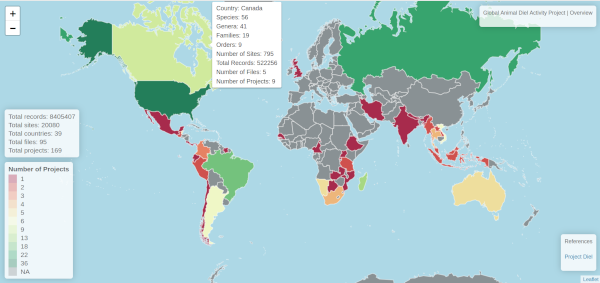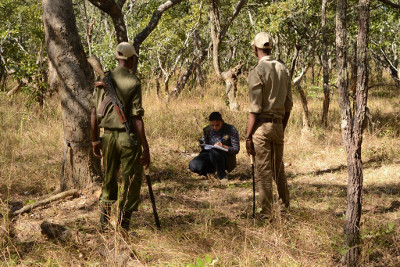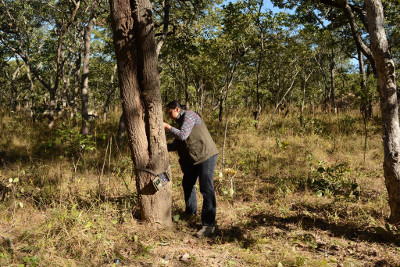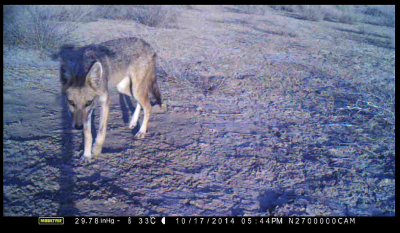Projects

"...deals the cards to find the answer
The sacred geometry of chance
The hidden law of a probable outcome
The numbers lead a dance"
-- Sting
I am an engineer-turned-ecologist (computer-scientist-turned-conservation-biologist, if you will) and my research involves applying quantitative tools to visualize and analyze scientific data. I’m fascinated by the sheer diversity of organisms on earth, how these organisms interact with each other, and how these interactions affect where they are found. I’m interested in how species are distributed in space and time, and how their interactions influence them at different levels - individual, population, community, ecosystem.
For my PhD in organismic and evolutionary biology at UMass, I worked on modeling wildlife communities with a focus on monitoring vertebrates. My PhD research focused on the effects of global change and species interactions on carnivore communities at multiple scales. At local scales, I investigated the abiotic and biotic drivers of carnivore community dynamics using a field study in a protected area in Zambia.
Temporal Ecology
Diel Activity

I am leading the Global Animal Diel Activity Project with Brian Gerber, Mason Fidino, and Zach Farris. Under this project, we are estimating mammal diel activity across the globe in a rigorous and comparable framework, focusing on non-volant mammals that are detectable via camera traps. We are using data from collaborators around the world, with millions of records for hundreds of species spanning thousands of sites in nearly forty countries.
Publications
Brian D Gerber, Kadambari Devarajan, Zach J Farris, Mason Fidino (2024), "A model-based hypothesis framework to define and estimate the diel niche via the 'Diel. Niche' R package", Journal of Animal Ecology. (Preprint on biorxiv)
Community Ecology
Carnivore Community Dynamics
Field site: Kasanka National Park (Zambia)


I am working with the Kasanka Trust on studying the entire carnivore community at Kasanka National Park. There are fifteen species of carnivores, ranging from leopards and hyenas to genets and otters, in the Park. I'm interested in understanding the effects of abiotic factors (such as habitat and climate) and species interactions on the distribution patterns of the different carnivores. This has enormous conservation implications in terms of long term monitoring of the populations.
My pilot study in the summer of 2019 was made possible thanks to funding from the UMass Natural History Collections Grant and the UMass OEB Research Grant. My dissertation research is funded through a National Geographic Early Career Grant, National Geographic Supplementary Grant for NatGeo Explorers, UMass Dissertation Fieldwork Grant, and UMass OEB Research Grant.
Collaborators - Toni Lyn Morelli, Jason Kamilar, and Geraldine Taylor
Publications
Kadambari Devarajan (September 2020), "Wildlife and Protected Areas During the Pandemic", That's Life[Science]
Kadambari Devarajan (September 2019), "More Tales from Trails", That's Life[Science]
Kadambari Devarajan (August 2019), "Tales from Trails - Field Dispatches from Africa", That's Life[Science]
Media Coverage
Carnivore Communities Across Scales
I am using existing data on mammals in the global tropics and sub-tropics to understand patterns of variation in carnivore community structure, richness, and function across different spatial scales.
Collaborators - John Rowan
Media Coverage
Reintroducing predators doesn’t always rebalance ecosystems - Shi En Kim - Massive Science
Canids and Competition
Field site: Banni Grasslands, Kutch (India)

I worked on understanding how a community of four co-occuring canids (golden jackal, Indian fox, desert fox, and domestic dog) partitioned space, time, habitat, and diet in an arid landscape. This was one of the first studies designed to study multiple species simultaneously, with an emphasis on incorporating species interactions.
This project was funded by the National Centre for Biological Sciences (NCBS), Wildlife Conservation Society (WCS) - India, Department of Science and Technology (DST) - Government of India, and Research and Monitoring in the Banni LandscapE (RAMBLE) Fellowship through the Thakar Jaikrishna Indraji Research Fund.
Publications
Kadambari Devarajan, "The Company Canids Confront: Spatiotemporal Partitioning at Local Scales Facilitates Carnivore Coexistence at the Landscape Level", in review (Preprint available on bioRxiv).
Kadambari Devarajan (November 2020), "Ecologically and Culturally Rich Deserts, Swamps and Grasslands Must Not be Labelled Wastelands", The Hindu - Sunday Magazine (Included in the monthly reading list put together by Uneven Earth)
Kadambari Devarajan (August 2019), "There Is Nary a Pest as Hated as Mesquite in the Desert Flatland of Kutch", The Wire
Kadambari Devarajan (April 2018), "The Field After Cancer", Fem Field Secrets blog
Kadambari Devarajan (September 2017), "A Salt County Almanac", Saevus (Issue: September 2017)
Kadambari Devarajan (February 2017), "Stories in the Sand", Celebrating Natural Heritage Souvenir (2017)
Media Coverage
Karayal - Swan Story
(Credited for camera trap footage from my research.)
Quantitative Ecology
Occupancy Modeling
I reviewed existing methods for studying communities including multi-species occupancy models (MSOMs) as well as coming up with best practices and frameworks for modeling communities, in a shift from studies focusing on single species.
Collaborators - Toni Lyn Morelli and Simone Tenan
Publications
Kadambari Devarajan, Toni Lyn Morelli, & Simone Tenan (2020), "Multi-species Occupancy Models - Review, Roadmap, and Recommendations", Ecography.
This paper was a finalist for the E4 Award, published in the special E4 Award edition of Ecography in November 2020, and featured in the Ecography podcast hosted by George Chan and Jodie Harris of Blue Fire Films.
Media Coverage
News: The Wildlife Society, USGS
Press Release: UMass News Office
Science News Aggregators: Science Daily, EurekAlert, Bioengineer.org, Phys.org
Statistical Ecology
Publications
Gordana Popovic, Tanya Jane Mason, Szymon Marian Drobniak, Tiago André Marques, Joanne Potts, Rocío Joo, Res Altwegg, Carolyn Claire Isabelle Burns, Michael Andrew McCarthy, Alison Johnston, Shinichi Nakagawa, Louise McMillan, Kadambari Devarajan, Patrick Leo Taggart, Alison Wunderlich, Magdalena M Mair, Juan Andrés Martínez‐Lanfranco, Malgorzata Lagisz, Patrice Pottier (2024), "Four Principles for Improved Statistical Ecology", Methods in Ecology and Evolution. (Preprint on arXiv)
Spatial Ecology
Field site: NCBS, Bengaluru and IIT Madras, Chennai (India)
I worked on a term paper for an invertebrate ecology course on the factors influencing the structure and arrangement of weaver ant nests in trees. With encouragement from the course instructor, I was able to convert an assignment into a journal publication.
Collaborators - Krushnamegh Kunte
Publications
Kadambari Devarajan (2016), "The Antsy Social Network: Determinants of Nest Structure and Arrangement in Asian Weaver Ants", PLoS ONE 11(6): e0156681. (Online, PDF 24.6MB)
Justice, Equity, Diversity, and Inclusion (JEDI)
I am part of several initiatives working towards enhancing diversity, equity, inclusion, and justice (DEIJ) at various levels. I compile and maintain a spreadsheet of DEIJ resources (articles, peer-reviewed publications, podcasts, videos, blog posts). I worked with Paige Warren and Craig Albertson to set up the UMass OEB DEIJ mission statement and resources page (OEB DEIJ Action Plan and slide deck of the DEIJ initiatives update). I initiated a weekly compilation of DEIJ-related events, media, articles, talks, and workshops called JEDI Journal that was shared with the OEB community that has been collated and archived on the OEB DEIJ page. As part of the UMass ECo DEI committee for 2020-21, I helped develop the ECo Anti-racism Action Plan and organize the ECo DEI Forum 2021.

(2020-21) | UMass Organismic & Evolutionary Biology (OEB) program's inaugural Justice, Equity, Diversity, and Inclusion (JEDI) Fellow
(2020-21) | UMass Department of Environmental Conservation (ECo) Diversity, Equity, and Inclusion (DEI) Committee graduate student representative
(2021-) | Smith College Kahn Fellow - "The Notorious RCG: Race, Class, and Gender in STEM"
(2019-20) | UMass Graduate Women in STEM (GWIS) - Diversity & Inclusion Co-Chair
(2018-21) | UMass BRiDGE - OEB program representative
Publications & Presentations
Nigel Golden, Kadambari Devarajan^*, Cathleen Balantic, Joseph Drake, Michael Hallworth, & Toni Lyn Morelli (2021), "Ten Simple Rules for Productive Lab Meetings", PLOS Computational Biology. (^ Joint first author) (Press Release: UMass News and Media Relations)
Paige Warren and Kadambari Devarajan, "Ecology & Evolution's Hidden Figures: A Community Learning Exercise Around Recent Articles on Diversity, Equity, Inclusion, and Justice", Invited webinar as part of the UMass OEB Seminar Series (November 2020).
Care Anderson, Elsa Cousins, Mariela Garcia Arredondo, Kadambari Devarajan, LeAnn Zuniga, Nigel Golden, Nicole Lee, Benjamin Keisling, Raquel Bryant, Nadia Fernandez, Katherine Chacon-Vargas, Brooke Burrows, RoseAnn Vik, Sungha Kang, & Sarah McCormick (November 2020), "BRiDGE: Enhancing diversity and inclusion in lecture series with broader impacts and mentoring opportunities", Agronomy/Crops/Soils Meeting 2020. (Poster)
Mariela Garcia Arredondo, Kadambari Devarajan, Carolyn Anderson, Emily Bechtold, Raquel Bryant, Brooke Burrows, Katherine Chacon-Vargas, Elsa Cousins, Adaeze Egwuatu, Nadia Fernandez, Nigel Golden, Srishti Kashyap, Benjamin Keisling, Sarah McCormick, & RoseAnn Vik (December 2019), "BRiDGE: Enhancing lecture series with broader impacts and mentoring opportunities", Centennial Meeting of the American Geophysical Union, San Francisco, CA, USA. (Abstract1)
Software
ViXeN : View eXtract and aNnotate media

Blog post: https://methodsblog.com/2019/05/14/vixen/
Paper: http://onlinelibrary.wiley.com/doi/10.1111/2041-210X.12892/full
Documentation: http://vixen.rtfd.io
Mailing list: https://groups.google.com/forum/#!forum/vixen
ViXeN is a simple tool to facilitate easily viewing, adding, and annotating metadata associated with media. ViXeN has been designed primarily to assist field biologists with managing the large amount of media they collect in a minimally intrusive manner. ViXeN is a special, customizable file browser with which one may view and edit metadata associated with media files like videos, images and audio.
It was designed and developed by Prabhu Ramachandran and me.
The documentation for ViXeN can be found on vixen.readthedocs.io. If you have any questions or are having any problems with ViXeN, please email or post your questions on the vixen-users mailing list.
Publication:
Prabhu Ramachandran & Kadambari Devarajan^ (September 2017), "ViXeN: An Open-source Package for Managing Multimedia Data", Methods in Ecology and Evolution (^ Joint first author) (Online version, PDF 808KB)
Kadambari Devarajan (May 2019), "ViXeN - View eXtract aNnotate Multimedia Data", Methods.blog
Diel.Niche